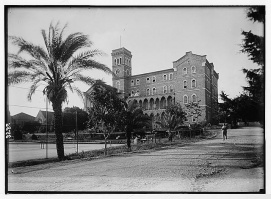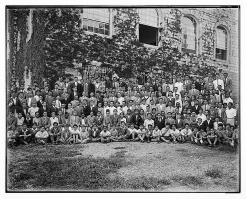The Syrian Protestant College at the Outset of the War↑
By the time the war broke out, the Syrian Protestant College (SPC) had established itself as one of the most respected foreign institutions in the region. Founded in 1866, the SPC operated on a philosophy of inclusiveness and tolerance that served it politically during the years preceding the conflict. In times of crisis, such as the Italian bombardment of 1912, the campus was seen as a safe haven by many in Beirut.
For years, the college had espoused a philosophy of accommodation with local authorities that helped it develop allies in the Syrian community, and its close association with the Beirut Chapter of the American Red Cross, the American Consul and activist groups like the Young Men's Christian Association (YMCA) provided additional social and political capital during the wartime years.
The Syrian Protestant College (SPC) during the War↑
The college was largely spared from the suffering of the surrounding areas during the war due to its diplomatic protection from the U.S. Consul, its relationship with Ahmet Cemal Pasha (1872-1922), and its support from the local community. President Howard Bliss (1860-1920) and Bayard Dodge (1888-1972) attempted to maintain security and continuity through the years of the war as much as possible for those on campus. Since the campus was the home of individuals from across the Arab world, Asia, Europe and America who would have been helpless without the institution, Bliss took special care to ensure the college remained open for the duration of the war.
The SPC and the Ottoman Authorities↑
The tenuousness of the SPC’s position as a foreign institution at the beginning of the war encouraged the college to make overtures to local authorities. The Red Cross expedition to the Suez front that was organized by the SPC’s Dr. Edwin St. John Ward (1880-1951) in 1915 gained credibility for the college and the Red Cross in the eyes of Ottoman Commander of the Fourth Army, Jamal Pasha. The mission was well received by the Ottoman medical corps. In a likely apocryphal story, one of the Ottoman officials thanked them for their help, saying that he had been desperate for supplies since army headquarters had only sent him boxes of obstetrical tools by mistake.
The SPC’s importance as a foreign institution was such that Jamal Pasha made it a matter of policy to ensure the provisioning of the campus during the war, allowing the foreign faculty to purchase food from the Army at standard military prices. Because the Ottomans purchased from local suppliers in paper lira at the fixed value, the cost of their provisions ranged as low as 20 percent of the cost of the same goods on the free market, where speculation in currency and commodities eventually drove prices to astounding heights. The college was permitted to feed its Syrian employees on campus, but a condition of their provisioning was that they could not allow their local employees to take food back to their families, some of who were suffering terribly from the high prices.
Although the college faced a number of challenges from local authorities, the police and Mehmet Cemal Azmi Bey (1868-1922), the Wali of Beirut, the college remained on favorable terms with the Ottoman state for the most part. The times of friction mainly revolved around changing policies, such as ‘Azmi’s prohibition of aid in Beirut and shifts in policy regarding questions of U.S. neutrality in the war. Apart from its forced recruitment of medical students and an aborted push to draft the college’s Iranian students, the SPC largely managed to avoid the impact of conscription on campus.
The medical graduates acquitted themselves well during the war, making such an impression on Jamal Pasha that even after the declaration of war by the United States, Jamal personally intervened to keep the medical faculty open. Over the course of the war, thirty-two doctors who had graduated from the SPC died while in military service.
When America declared war against Germany and broke relations with Istanbul, the college was briefly closed, but was re-opened after the Ottoman leaders again confirmed the rights of the institution. Jamal Pasha was personally impressed by the operation of the college, its medical institutions and its faculty, which were regarded highly enough that the Ottoman Ministry of Education had sent an official to conduct an inquiry into the college seeking to understand the keys to its success.
The most daunting challenge was the “Geography Incident,” a scandal fomented to implicate the college at a time of tension between America and Germany. The textbook used by Professor William Hall included several damning passages about the Ottoman Empire, which the college elided in its curriculum. When the pages were publicized however, there was a political uproar. After a period of tension, Bliss negotiated an acceptable solution to the problem, which prevented Hall’s deportation and allowed the college to remain operational.
Campus Life during the War↑
Although the wartime famine that lasted from 1915 to 1918 had dire consequences for thousands of Syrians and Lebanese, the campus itself was largely shielded from most of the direct suffering. Attendance decreased over the course of the war as tuition became onerous for many families, or students returned to their villages to attempt to support their families during the crisis. The pinch of the famine was felt in the rise in petty theft across campus and the occasional outbreak of disease, particularly during eruptions of typhus and malaria. A number of the faculty members who wrote on their experience of the crisis referred to the intense emotional effects of the war and the famine on daily life during the period.
Professor Bayard Dodge arranged for leisure activities, socials, film screenings, plays and other diversions to leaven the otherwise monotonous atmosphere of the war. Field days and athletic activities continued as usual, and while the U.S. Navy remained stationed off the coast, the college teams frequently staged competitions against the sailors.
Relief Work and the SPC↑
Although the SPC did not officially engage in relief work, faculty and its affiliate institutions were among the most active organizers of the humanitarian aid programs that were assembled during the crisis. The most notable among these was the Beirut Chapter of the American Red Cross, which was led by Dr. Patch of the SPC Medical School (who officially served as its Vice President). The Red Cross spearheaded a campaign to distribute money and food across Beirut in 1915, as well as an employment program to create work for those affected by the closure of the port. The arrival of ‘Azmi Bey in August 1915 shuttered its operations in the city, forcing it to move to Mount Lebanon, where it teamed with the Ottoman Red Crescent under the blessing of Mutasarrif ‘Ali Munif Bey (1874-1951). Students aided the programs, initially through the school’s chapter of the YMCA and later as independent volunteers.
Two private aid programs were started in the Gharb and Metn regions, led by SPC Drs. Bayard Dodge and Arthur Dray (1875-1926). Dray, a British dentist who had been deported and reinstated after Howard Bliss intervened with Jamal Pasha, gained immense political influence after offering covert medical assistance to a companion of Jamal Pasha in Palestine and repairing a dental abscess for Beirut’s Wali ‘Azmi Bey. In 1916, he approached Jamal Pasha to ask for permission to expand a soup kitchen that had been established in Brummana by the Cortass and Rizq families. Thanks to his influence, he eventually gained the right to purchase military provisions for five months and Jamal’s blessing to operate additional works in Aleih and Shweir. The Brummana orphanage, shelter and soup kitchen became the showcase operation of the mountain, gaining the patronage of Ottomans, Germans, Americans and Syrians alike to cover the $180,000 in cost that its operations required.
Dodge ran two smaller operations in Abeih and Suk al-Gharb, as well as shelters in ‘Ainab and Shimlan. Moreover, he played a key role in the establishment of the American Relief Committee, which combined the forces of the Red Cross and American Mission in late 1917 to better coordinate aid and funding.
The SPC and the Paris Peace Conference (1919)↑
Following the war, President Howard Bliss attended the Paris Peace Conference with a group of Arab delegates to advise on the postwar settlement. He consulted with numerous parties on the wisdom of the mandates, advising that the opinions of the Arab inhabitants of the areas in question be respected in whatever system was eventually established. This sentiment was reflected in the American King-Crane Commission of 1919, whose findings were ultimately brushed aside in the final Mandate agreements.
Tylor Brand, American University Beirut
Section Editor: Abdul Rahim Abu-Husayn
Selected Bibliography
- Ajay, Nicholas: Mount Lebanon and the Wilayat of Beirut, 1914-1918, thesis, Washington, D.C. 1972: Georgetown University.
- Brand, Tylor: 'That they may have life'. Balancing principles and pragmatism in the Syrian Protestant College’s humanitarian relief projects during the famine of World War I, in: El-Cheikh, Nadia Maria / Choueiri, Lina / Urfahʹlī, Bilāl (eds.): One hundred and fifty, Beirut 2016: American University of Beirut, pp. 51-62.
- Dodge, Bayard: The American University of Beirut. A brief history of the university and the lands which it serves, Beirut 1958: Khayat's.
- Grabill, Joseph L.: Protestant diplomacy and the Near East. Missionary influence on American policy, 1870-1927, Minneapolis 1971: University of Minnesota Press.
- Penrose, Stephen B. L.: That they may have life. The story of the American University of Beirut, 1866-1941, New York 1941: Trustees of the American University of Beirut.









